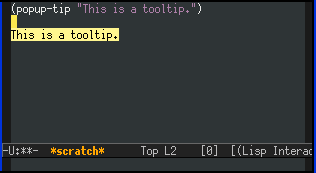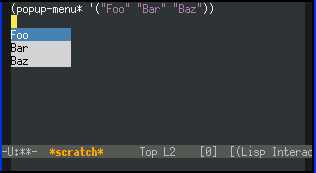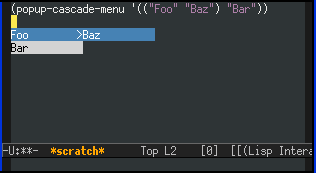popup.el is a visual popup user interface library for Emacs. This provides a basic API and common UI widgets such as popup tooltips and popup menus.
| Tooltip | Popup Menu | Popup Cascade Menu |
|---|---|---|
 |
 |
 |
You can install popup.el from MELPA with package.el.
popwin is tested under GNU Emacs 24 or later.
Alternatively, users of Debian 9 or later or Ubuntu 16.04 or later may
simply apt-get install elpa-popup.
Elements of popup-list have to be popup items. A popup item is
substantially a string but it may involve some text-properties. There
are two ways to make popup items. One is just using strings. Another
is to use the popup-make-item function, which just returns the string
after adding text-properties of its keywords. Effective text-properties
are:
value-- This represents the real value of the item. This will be used when returning the value but not the item (or string) from some synchronous functions such aspopup-menu*.face-- The background face of the item. The value ofpopup-facewill be overridden.selection-face-- The selection face of the item. The value ofpopup-selection-facewill be overridden.document-- The documentation string or function of the item.summary-- The summary string of the item. This will be shown inline with the item.symbol-- The symbol character of the item.sublist-- The sublist of the item. This is effective only withpopup-cascade-menu.
All of properties can be accessed by popup-item-<property> utility function.
popup-item-propertize item &rest properties => item
Same as propertize except that this avoids overriding existed value
with nil property.
popup-make-item name &key value popup-face selection-face sublist
document symbol summary => item
The utility function of popup-item-propertize.
This section describes the basic data structures and operations of popups.
Any instance of popup structure has the following fields (some
unimportant fields are not listed):
pointrow-- The line number.columnwidth-- Max width ofpopupinstance.height-- Max height ofpopupinstance.min-heightcurrent-heightdirection-- Positive number means forward, negative number means backward.parent-- The parent ofpopupinstance.face-- The background face.selection-facemargin-leftmargin-rightscroll-bar-- Non-nil meanspopupinstance has a scroll bar.symbol-- Non-nil meanspopupinstance has a space for displaying symbols of item.cursor-- The current position oflist.scroll-top-- The offset of scrolling.list-- The contents ofpopupinstance in a list of items (strings).original-list-- Same aslistexcept that this is not filtered.
All of these fields can be accessed by popup-<field> function.
popup-create point width height &key min-height max-width around face
selection-face scroll-bar margin-left margin-right symbol parent
parent-offset => popup
Create a popup instance at POINT with WIDTH and HEIGHT.
MIN-HEIGHT is the minimal height of the popup. The default value is 0.
MAX-WIDTH is the maximum width of the popup. The default value is
nil (no limit). If a floating point, the value refers to the ratio of
the window. If an integer, limit is in characters.
If AROUND is non-nil, the popup will be displayed around the point
but not at the point.
FACE is the background face of the popup. The default value is
popup-face.
SELECTION-FACE is the foreground (selection) face of the popup The
default value is popup-face.
If SCROLL-BAR is non-nil, the popup will have a scroll bar at the
right.
If MARGIN-LEFT is non-nil, the popup will have a margin at the left.
If MARGIN-RIGHT is non-nil, the popup will have a margin at the
right.
SYMBOL is a single character which indicates the kind of the item.
PARENT is the parent popup instance. If PARENT is omitted, the popup
will be a root instance.
PARENT-OFFSET is a row offset from the parent popup.
Here is an example:
(setq popup (popup-create (point) 10 10))
(popup-set-list popup '("Foo" "Bar" "Baz"))
(popup-draw popup)
;; do something here
(popup-delete popup)popup-delete popup
Delete the POPUP.
popup-live-p popup => boolean
popup-set-list popup list
Set the contents of the POPUP. LIST has to be popup items.
popup-draw popup
Draw the contents of the POPUP.
popup-hide popup
Hide the POPUP. To show again, call popup-draw.
Function: popup-hidden-p
popup-hidden-p popup
Return non-nil if the POPUP is hidden.
popup-select popup index
Select the item of INDEX of the POPUP.
popup-selected-item popup => item
Return the selected item of the POPUP.
Return non-nil if the POPUP is still alive.
popup-next popup
Select the next item of the POPUP.
popup-previous popup
Select the next item of the POPUP.
popup-scroll-down popup n
Scroll down N items of the POPUP. This won't wrap.
popup-scroll-up popup n
Scroll up N items of the POPUP. This won't wrap.
popup-isearch popup &key cursor-color keymap callback help-delay
=> boolean
Enter incremental search event loop of POPUP.
A tooltip is an useful visual UI widget for displaying information something about what cursor points to.
popup-tip string &key point around width height min-height max-width
truncate margin margin-left margin-right scroll-bar parent
parent-offset nowait nostrip prompt
Show a tooltip with message STRING at POINT. This function is
synchronized unless NOWAIT specified. Almost all arguments are same as
popup-create except for TRUNCATE, NOWAIT, NOSTRIP and PROMPT.
If TRUNCATE is non-nil, the tooltip can be truncated.
If NOWAIT is non-nil, this function immediately returns the tooltip
instance without entering event loop.
If NOSTRIP is non-nil, STRING properties are not stripped.
PROMPT is a prompt string used when reading events during the event
loop.
Here is an example:
(popup-tip "Hello, World!")
;; reach here after the tooltip disappearedPopup menu is an useful visual UI widget for prompting users to select an item of a list.
popup-menu* list &key point around width height margin margin-left
margin-right scroll-bar symbol parent parent-offset keymap
fallback help-delay nowait prompt isearch isearch-filter isearch-cursor-color
isearch-keymap isearch-callback initial-index => selected-valueShow a popup menu of LIST at POINT. This function returns the value
of the selected item. Almost all arguments are same as popup-create
except for KEYMAP, FALLBACK, HELP-DELAY, PROMPT, ISEARCH,
ISEARCH-FILTER, ISEARCH-CURSOR-COLOR, ISEARCH-KEYMAP
and ISEARCH-CALLBACK.
If KEYMAP is provided, it is a keymap which is used when processing
events during event loop.
If FALLBACK is provided, it is a function taking two arguments; a key
and a command. FALLBACK is called when no special operation is found
on the key. The default value is popup-menu-fallback, which does
nothing.
HELP-DELAY is a delay of displaying helps.
If NOWAIT is non-nil, this function immediately returns the menu
instance without entering event loop.
PROMPT is a prompt string when reading events during event loop.
If ISEARCH is non-nil, do isearch as soon as displaying the popup
menu.
ISEARCH-FILTER is a filtering function taking two arguments:
search pattern and list of items. Returns a list of matching items.
ISEARCH-CURSOR-COLOR is a cursor color during isearch. The default
value is `popup-isearch-cursor-color'.
ISEARCH-KEYMAP is a keymap which is used when processing events
during event loop. The default value is popup-isearch-keymap.
ISEARCH-CALLBACK is a function taking one argument. popup-menu
calls ISEARCH-CALLBACK, if specified, after isearch finished or
isearch canceled. The arguments is whole filtered list of items.
If INITIAL-INDEX is non-nil, this is an initial index value for
popup-select. Only positive integer is valid.
Here is an example:
(popup-menu* '("Foo" "Bar" "Baz"))
;; => "Baz" if you select Baz
(popup-menu* (list (popup-make-item "Yes" :value t)
(popup-make-item "No" :value nil)))
;; => t if you select YesSame as popup-menu except that an element of LIST can be also a
sub-menu if the element is a cons cell formed (ITEM . SUBLIST) where
ITEM is an usual item and SUBLIST is a list of the sub menu.
Here is an example:
(popup-cascade-menu '(("Top1" "Sub1" "Sub2") "Top2"))Function used to construct a regexp from a pattern. You may for instance
provide a function that replaces spaces by '.+' if you like helm or ivy style
of completion. Default value is #'regexp-quote.
Copyright (C) 2011-2015 Tomohiro Matsuyama <[email protected]>
Copyright (C) 2020-2022 Jen-Chieh Shen <[email protected]>
